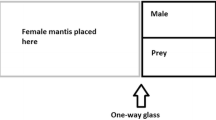Abstract
The experiments described in this paper are part of a series designed to clarify the behavioral function of the odor of the secretion from the inguinal glands of rabbits,Oryctolagus cuniculus. Results are presented of tests carried out on 48 mixed-sex groups consisting of 162 adult wild-type rabbits, 48 males and 114 females. The subordinate females of the groups were smeared with various odorous materials and the reactions of their pen-mates towards them recorded. Eight sources of natural rabbit odors and a commercial perfume were used in 198 tests. A high proportion (60%) of the subordinate females smeared with the inguinal gland secretions from unfamiliar males were attacked, mainly by the males, which were generally the most dominant individuals within the groups. The paper also presents statistical analyses of behavioral data collected during two earlier related experiments with single-sex groups involving 258 rabbits in 300 tests which have not previously been evaluated. The results throughout the whole study indicate clearly that the odor of the inguinal gland secretion of rabbits carries information which affects the acceptance of individuals by their companions in organized groups. Other sources of unfamiliar rabbit odor did not influence the attitude of groupmates toward the individuals smeared with them, or if they did, their effects were only marginal.
Similar content being viewed by others
References
Bell, D.J. 1980. Social olfaction in lagomorphs,in D.M. Stoddart (ed.). Olfaction in Mammals, pp. 141–164, Academic Press, London.
Bowers, J.M., andAlexander, B.K. 1967. Mice: Individual recognition by olfactory cues.Science 158:1208–1210.
Goodrich, B.S., andMykytowycz, R. 1972. Individual and sex differences in the chemical composition of pheromone-like substances from the skin glands of rabbits,Oryctolagus cuniculus. J. Mammal 53:540–548.
Goodrich, B.S., Hesterman, E.R., andMykytowycz, R. 1981. Effect of volatiles collected above fecal pellets on behavior of the rabbit,Oryctolagus cuniculus, tested in an experimental chamber. II. Gas Chromatographie fractionation of trapped volatiles.J. Chem. Ecol. 7:947–959.
Gorman, M.L. 1976. A mechanism for individual recognition by odour inHerpestes autopunctalus (Carnivora: Viverridae).Anim. Behav. 24:141–145.
Halpin, Z.T. 1976. The role of individual recognition by odors in the social interactions of the Mongolian gerbil (Meriones unguiculatus). Behaviour 58:117–130.
Halpin, Z.T. 1980. Individual odors and individual recognition: Review and commentary.Biol. Behav. 5:233–248.
Harrington, J.E. 1976. Discrimination between individuals by scent inLemur fulvus.Anim. Behav. 24:207–212.
Hesterman, E.R., andMykytowycz, R. 1982a. Misidentification by wild rabbits,Oryctolagus cuniculus, of group members carrying the odor of foreign inguinal gland secretion. I. Experiments with all-male groups.J. Chem. Ecol. 8:419–427.
Hesterman, E.R., andMykytowycz, R. 1982b. Misidentification by wild rabbits,Oryctolagus cuniculus, of group members carrying the odor of foreign inguinal gland secretion. II. Experiments with all-female groups.J. Chem. Ecol. 8:723–729.
Hesterman, E.R., Goodrich, B.S., andMykytowycz, R. 1981. Effect of volatiles collected above fecal pellets on behavior of the rabbit,Oryctolagus cuniculus, tested in an experimental chamber. I. Total volatiles and some chemically prepared fractions.J. Chem. Ecol. 7:799–815.
Mykytowycz, R., andDudziński, M.L. 1972. Aggressive and protective behaviour of adult rabbits,Oryctolagus cuniculus (L.) towards juveniles.Behaviour 43:97–119.
Mykytowycz, R., andGoodrich, B.S. 1974. Skin glands as organs of communication in mammals.J. Invest. Dermatol. 62:124–131.
Mykytowycz, R., Hesterman, E.R., Gambale, S., andDudzinski, M.L. 1976. A comparison of the effectiveness of the odors of rabbits,Oryctolagus cuniculus, in enhancing territorial confidence.J. Chem. Ecol. 2:13–24.
Author information
Authors and Affiliations
Rights and permissions
About this article
Cite this article
Hesterman, E.R., Malafant, K. & Mykytowycz, R. Misidentification by wild rabbits,Oryctolagus cuniculus, of group members carrying the odor of foreign inguinal gland secretion. J Chem Ecol 10, 403–419 (1984). https://doi.org/10.1007/BF00988088
Received:
Revised:
Issue Date:
DOI: https://doi.org/10.1007/BF00988088




